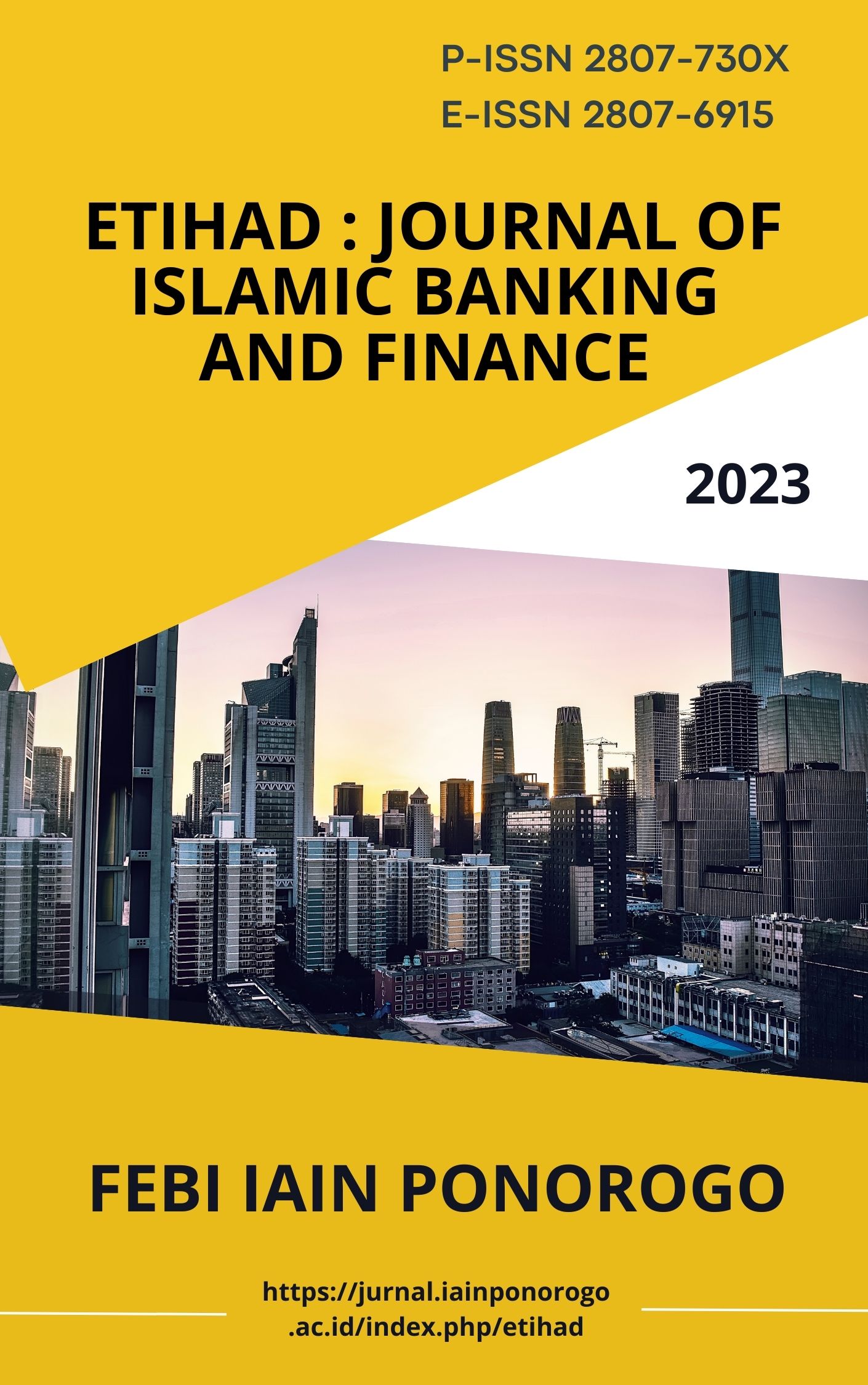Factors that Influence to Costumers Sharia Bank Loyalty: An Empirical Study of Students at Universitas Darussalam Gontor Ponorogo
DOI:
https://doi.org/10.21154/etihad.v3i2.7774Abstract
Introduction: The purpose of this research is to predict customer satisfaction, customer perceived value, and customer Islamic religiosity on Sharia bank customer loyalty. Research Methods: The research used a quantitative approach with 140 respondents who were Sharia bank customers, specifically students at Universitas Darussalam Gontor, Ponorogo. A Likert scale of 1-5 was employed for measurement, and partial least squares”“structural equation modeling was used to analyze the data. Results: The results of this research demonstrate that customer satisfaction, perceived value, and Islamic religiosity have a significantly positive impact on Sharia bank customer loyalty. Conclusion: To build and maintain customer loyalty, Islamic banks must leverage customer satisfaction, value, and religiosity by offering a variety of Sharia-based products and services that truly differentiate them from conventional banks.References
Ali, M. A., & Hussain, T. (2021). Islamic Banking Products, Services and Objectives: Perspectives of Shariah Supervisors and Regulators. International Review of Management and Business Research, 10(1), 247”“258. https://doi.org/10.30543/10-1(2021)-21
Ashraf Ali, K. (2016). Impact of Religiosity on Buying Behavior of Financial Products: A Literature Review. International Journal of Finance and Banking Research, 2(1), 18. https://doi.org/10.11648/j.ijfbr.20160201.14
Aslam, E., Ashraf, M. S., & Iqbal, A. (2022). Impact of corporate image on customer loyalty of Islamic banks: the role of religiosity, collectivism, sight cues and CSR. Journal of Islamic Marketing, 14(5), 1310”“1324. https://doi.org/10.1108/JIMA-09-2021-0314
Bakar, J. A., Clemes, M. D., & Bicknell, K. (2017). A Comprehensive Hierarchical Model Of Retail Banking. International Journal of Bank Marketing, 35(4), 662”“684. https://doi.org/10.1108/IJBM-03-2016-0041
Chin, W. W. (2010). How to Write Up and Report PLS Analyses. In Handbook of Partial Least Squares. https://doi.org/10.1007/978-3-540-32827-8_29
Fusva, A., Dean, D., Suhartanto, D., Syarief, M. E., Arifin, A. Z., Suhaeni, T., & Rafdinal, W. (2020). Loyalty formation and its impact on financial performance of Islamic banks ”“ evidence from Indonesia. Journal of Islamic Marketing, 12(9), 1872”“1886. https://doi.org/10.1108/JIMA-12-2019-0258
Hair, J. F., Hult, G. T. M., Ringle, C. M., & Sarstedt, M. (2017). A Primer on Partial Least Squares Structural Equation Modeling (PLS-SEM). In Sage. Sage.
Hamouda, M. (2019). Omni-channel banking integration quality and perceived value as drivers of consumers’ satisfaction and loyalty. Journal of Enterprise Information Management, 32(4), 608”“625. https://doi.org/10.1108/JEIM-12-2018-0279
Henseler, J., Ringle, C. M., & Sarstedt, M. (2015). A new criterion for assessing discriminant validity in variance-based structural equation modeling. Journal of the Academy of Marketing Science, 43(1), 115”“135. https://doi.org/10.1007/s11747-014-0403-8
Iqbal, M., Nisha, N., & Rashid, M. (2018). Bank selection criteria and satisfaction of retail customers of Islamic banks in Bangladesh. International Journal of Bank Marketing, 36(5), 931”“946. https://doi.org/10.1108/IJBM-01-2017-0007
Joseph F. Hair, J., Hult, G. T. M., Rigle, C. M., & Sarstedt, M. (2022). A Primer on Partial Least Squares Structural Equation Modeling (PLS-SEM) (3rd ed.). Sage.
Muflih, M. (2021). The Link between Corporate Social Responsibility and Customer Loyalty: Empirical Evidence from the Islamic Banking Industry. Journal of Retailing and Consumer Services, 61(November 2020), 102558. https://doi.org/10.1016/j.jretconser.2021.102558
Oliver, Ricard L. (1999). Whence consumer loyalty? Journal of Marketing, 63(1999), 33.
Oliver, Richard L, & Desarbo, W. S. (1988). Response Satisfaction Determinants in Judgments. Journal of Consumer Research, 14(4), 495”“507.
Schumacker, R. E., & Lomax, R. G. (2015). A Beginner’s Guide to Structural Equation Modeling. In A Beginner’s Guide to Structural Equation Modeling (4th ed.). Routledge Taylor & Francis Group. https://doi.org/10.4324/9781315749105
Suhartanto, D., Farhani, N. H., Muflih, M., & Setiawan. (2018). Loyalty Intention Towards Islamic Bank: The Role Of Religiosity, Image, And Trust. International Journal of Economics and Management, 12(1), 137”“151.
Suhartanto, D., Gan, C., Sarah, I. S., & Setiawan, S. (2019). Loyalty towards Islamic banking: service quality, emotional or religious driven? Journal of Islamic Marketing, 11(1), 66”“80. https://doi.org/10.1108/JIMA-01-2018-0007
Suhartanto, D., Syarief, M. E., Chandra Nugraha, A., Suhaeni, T., Masthura, A., & Amin, H. (2022). Millennial loyalty towards artificial intelligence-enabled mobile banking: evidence from Indonesian Islamic banks. Journal of Islamic Marketing, 13(9), 1958”“1972. https://doi.org/10.1108/JIMA-12-2020-0380
Tegambwage, A. G., & Kasoga, P. S. (2023). Determinants of customer loyalty in Islamic banking: the role of religiosity. Journal of Islamic Marketing. https://doi.org/10.1108/JIMA-12-2021-0396
Wahyuni, S., & Fitriani, N. (2017). Brand religiosity aura and brand loyalty in Indonesia Islamic banking. Journal of Islamic Marketing, 8(3), 361”“372. https://doi.org/10.1108/JIMA-06-2015-0044
Wijaya, T., Nasuka, M., & Hidayat, A. (2021). Salesperson ethics behavior as antecedent of Islamic banking customer loyalty. Journal of Islamic Marketing. https://doi.org/10.1108/JIMA-04-2020-0100
Downloads
Published
Issue
Section
License
Copyright (c) 2025 Azidni Rofiqo, Febrian Arif Wicaksana, Abdurrizqi Bin Abd Razak

This work is licensed under a Creative Commons Attribution-NonCommercial 4.0 International License.
Etihad: Journal of Islamic Banking and Finance allow the author(s) to hold the copyright without restrictions and allow the author(s) to retain publishing rights without restrictions, also the owner of the commercial rights to the article is the author.







